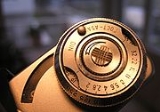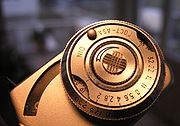
Selenium meter
Encyclopedia
A selenium meter is a light-measuring instrument based on the photoelectric properties of selenium
. The most common use of such light meter
s is measuring the exposure value
for photography. The electric part of such a meter is an electromagnetic measuring instrument which is connected to the anode
and cathode
of a selenium photo cell that produces more or less electric power when exposed to more or less light. The optical part of such a meter is a window in front of the photo cell's light-sensitive side. The window's surface is usually structured like a honeycomb made of convex lenses. This type of window helps to bundle the light coming from the direction in which the photo cell is pointed. The mechanical part of a selenium meter is an analog calculator which accepts exposure value and film speed as input parameters for showing the possible aperture and shutter-speed combinations for correct exposure.
 The simplest type of match-needle selenium meter shows a clockhand on the meter's scale. This can be moved by turning one slice of the analog calculator. When the clockhand matches the instrument's needle the EV-value is set right on the calculator.
The simplest type of match-needle selenium meter shows a clockhand on the meter's scale. This can be moved by turning one slice of the analog calculator. When the clockhand matches the instrument's needle the EV-value is set right on the calculator.
The picture on the right shows the device of the Zenit
- E model, mounted on a left side of the camera. The inner (flat) circle rotates with the help of the knob and sets the film sensitivity (visible in both DIN
and ASA
units through tiny windows). The outer circle is coupled to the moving O - shaped marker in the scale on the left and must be rotated till the marker covers the needle (visible in the left corner). The recommended exposures can be read on a side scale against the possible apertures (top scale). The device is not directly coupled to actual aperture and exposure controls
Another type is common especially where a selenium meter is built into a camera. Then the scale of the instrument shows just one mark. When the needle matches that mark the user can see appropriate aperture/shutter-speed combinations on the analog calculator.
 More sophisticated cameras have the match-needle instrument coupled directly to aperture and shutter speed setting rings on the lens tube instead to a separate analog calculator. This is the most convenient way of match-needle instrument usage, especially when the meter's scale is mirrored into the viewfinder.
More sophisticated cameras have the match-needle instrument coupled directly to aperture and shutter speed setting rings on the lens tube instead to a separate analog calculator. This is the most convenient way of match-needle instrument usage, especially when the meter's scale is mirrored into the viewfinder.
In the beginnings of exposure automation (ca. 1960) the instruments were even used for setting exposure settings directly, mainly for automatic aperture setting. A simple method for this was called "trap-needle"; pressing the shutter release mechanically gripped the meter needle, then moved an aperture control up to hit the needle, setting the aperture to a value controlled by the meter.
This kind of attempt to automate exposure setting was common in an era were precision mechanical engineers didn't know any limits of complication so that even further steps were gone to use selenium photo cells to control all exposure settings, or to control them more exactly with help of electro-mechanical aids. Heinz Waaske
's SLR construction Edixa Electronica was such a costly attempt. The construction problem was the low electric power delivered by the photo cell. It was a precision mechanical wonder that a handful of cameras were made which had automatic exposure control driven by a selenium meter, without need of further electronic or electromechanical support, for example the Optima.
A compromise for expensive rangefinder
or SLR
cameras was to offer a selenium meter as optional device that could be coupled to the cameras's shutter speed controls. The scale of these instruments show not an exposure value but an aperture value to be set "uncoupled". An example is shown in the photograph
Selenium
Selenium is a chemical element with atomic number 34, chemical symbol Se, and an atomic mass of 78.96. It is a nonmetal, whose properties are intermediate between those of adjacent chalcogen elements sulfur and tellurium...
. The most common use of such light meter
Light meter
A light meter is a device used to measure the amount of light. In photography, a light meter is often used to determine the proper exposure for a photograph...
s is measuring the exposure value
Exposure value
In photography, exposure value denotes all combinations of a camera's shutter speed and relative aperture that give the same exposure. In an attempt to simplify choosing among combinations of equivalent camera settings, the concept was developed by the German shutter manufacturer in the 1950s...
for photography. The electric part of such a meter is an electromagnetic measuring instrument which is connected to the anode
Anode
An anode is an electrode through which electric current flows into a polarized electrical device. Mnemonic: ACID ....
and cathode
Cathode
A cathode is an electrode through which electric current flows out of a polarized electrical device. Mnemonic: CCD .Cathode polarity is not always negative...
of a selenium photo cell that produces more or less electric power when exposed to more or less light. The optical part of such a meter is a window in front of the photo cell's light-sensitive side. The window's surface is usually structured like a honeycomb made of convex lenses. This type of window helps to bundle the light coming from the direction in which the photo cell is pointed. The mechanical part of a selenium meter is an analog calculator which accepts exposure value and film speed as input parameters for showing the possible aperture and shutter-speed combinations for correct exposure.
Match-needle meters

The picture on the right shows the device of the Zenit
Zenit (camera)
Zenit is a Russian camera brand manufactured by KMZ in the town of Krasnogorsk near Moscow since 1952 and by BelOMO in Belarus since the 1970s. The Zenit trademark is associated with 35mm SLR cameras...
- E model, mounted on a left side of the camera. The inner (flat) circle rotates with the help of the knob and sets the film sensitivity (visible in both DIN
Din
DIN or Din or din can have several meanings:* A din is a loud noise.* Dīn, an Arabic term meaning "religion" or "way of life".* Din is one of the ten aspects of the Ein Sof in Kabbalah ....
and ASA
Film speed
Film speed is the measure of a photographic film's sensitivity to light, determined by sensitometry and measured on various numerical scales, the most recent being the ISO system....
units through tiny windows). The outer circle is coupled to the moving O - shaped marker in the scale on the left and must be rotated till the marker covers the needle (visible in the left corner). The recommended exposures can be read on a side scale against the possible apertures (top scale). The device is not directly coupled to actual aperture and exposure controls
Another type is common especially where a selenium meter is built into a camera. Then the scale of the instrument shows just one mark. When the needle matches that mark the user can see appropriate aperture/shutter-speed combinations on the analog calculator.
Coupled meters

In the beginnings of exposure automation (ca. 1960) the instruments were even used for setting exposure settings directly, mainly for automatic aperture setting. A simple method for this was called "trap-needle"; pressing the shutter release mechanically gripped the meter needle, then moved an aperture control up to hit the needle, setting the aperture to a value controlled by the meter.
This kind of attempt to automate exposure setting was common in an era were precision mechanical engineers didn't know any limits of complication so that even further steps were gone to use selenium photo cells to control all exposure settings, or to control them more exactly with help of electro-mechanical aids. Heinz Waaske
Heinz Waaske
Heinz Waaske was a German camera designer, notably father of the Rollei 35.- Early career :Born in Berlin, Heinz Waaske started his career as a precision mechanic apprentice at Telefunken in Sickingenstraße in Berlin, where he studied from 1939 to 1942...
's SLR construction Edixa Electronica was such a costly attempt. The construction problem was the low electric power delivered by the photo cell. It was a precision mechanical wonder that a handful of cameras were made which had automatic exposure control driven by a selenium meter, without need of further electronic or electromechanical support, for example the Optima.
A compromise for expensive rangefinder
Rangefinder camera
A rangefinder camera is a camera fitted with a rangefinder: a range-finding focusing mechanism allowing the photographer to measure the subject distance and take photographs that are in sharp focus...
or SLR
SLR
The initialism SLR can refer to:* Satellite laser ranging* Scalable Linear Recording Tape Drive Backup* Self-Loading Rifle, see semi-automatic rifle.** The UK version of the Belgian FN FAL select fire battle rifle, the L1A1 SLR.* Semi-linear resolution...
cameras was to offer a selenium meter as optional device that could be coupled to the cameras's shutter speed controls. The scale of these instruments show not an exposure value but an aperture value to be set "uncoupled". An example is shown in the photograph

